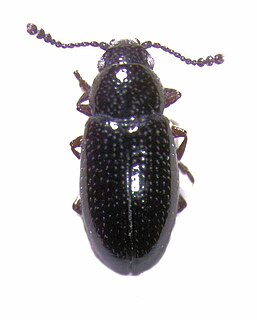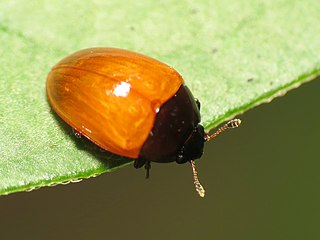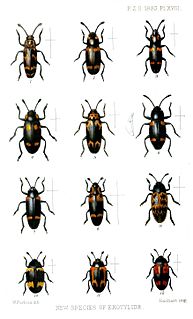Loberus ornatus is a species of pleasing fungus beetle in the family Erotylidae. It is found in North America.

Loberus is a genus of pleasing fungus beetles in the family Erotylidae. There are about 13 described species in Loberus.
Microsternus ulkei is a species of pleasing fungus beetle in the family Erotylidae. It is found in North America.
Triplax flavicollis is a species of pleasing fungus beetle in the family Erotylidae. It is found in Central America and North America.
Cryptophilus seriatus is a species of pleasing fungus beetle in the family Erotylidae. It is found in North America.

Languria angustata is a species of lizard beetle in the family Erotylidae. It is found in North America.

Megalodacne heros, the pleasing fungus beetle, is a species of pleasing fungus beetle in the family Erotylidae. It is found in North America.
Hapalips texanus is a species of pleasing fungus beetle in the family Erotylidae. It is found in North America.
Tritoma pulchra, the handsome tritoma, is a species of pleasing fungus beetle in the family Erotylidae. It is found in North America.

Gibbifer californicus, known generally as the blue fungus beetle or blue pleasing fungus beetle, is a species of pleasing fungus beetle in the family Erotylidae. It is found in North America.
Tritoma atriventris is a species of pleasing fungus beetle in the family Erotylidae. It is found in North America.
Tritoma tenebrosa, the darkling tritoma, is a species of pleasing fungus beetle in the family Erotylidae. It is found in North America.
Dacne californica is a species of pleasing fungus beetle in the family Erotylidae. It is found in Central America and North America.

Tritoma sanguinipennis, the red-winged tritoma, is a species of pleasing fungus beetle in the family Erotylidae. It is found in North America.
Triplax thoracica is a species of pleasing fungus beetle in the family Erotylidae. It is found in North America.
Triplax macra is a species of pleasing fungus beetle in the family Erotylidae. It is found in North America.
Triplax puncticeps is a species of pleasing fungus beetle in the family Erotylidae. It is found in North America.
Tritoma unicolor is a species of pleasing fungus beetle in the family Erotylidae. It is found in North America.
Dacne quadrimaculata is a species of pleasing fungus beetle in the family Erotylidae. It is found in North America.
Triplax mesosternalis is a species of pleasing fungus beetle in the family Erotylidae. It is found in Central America and North America.







